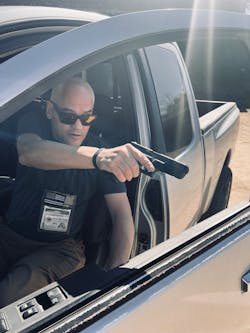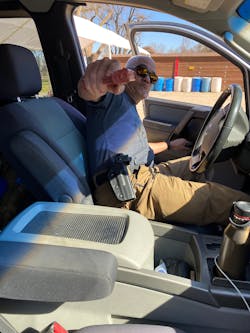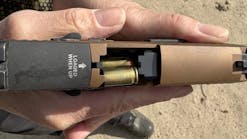Vehicle Ops & Ambush Mitigation
Depending on the nature of their assignment, an officer on patrol can spend around 50% of their time at work in their patrol car. A patrol vehicle is often seen as a means to get the officer to the call. It can, however, be a bad place to be during an ambush.
This article is about some simple knowledge an officer can have about vehicle ops. It has some pointers about safety. It cannot possibly be about ambush mitigation, because the topic is too broad. For example, who would ambush an officer? Before we can talk about ambush mitigation, we need to see if there is something in common amongst those who would shoot an officer. If there is a common ideology, we should identify it, and address it.An Officer in a Stopped Vehicle is a Fixed Target
Once the vehicle has stopped, the officer is a fixed target. This sounds like a no-brainer, but you are hearing this because of the second part of the rule. You see, the only reason I would shoot from a vehicle is if I am forced to shoot from a vehicle. The idea is to avoid shooting from a vehicle.
If a person arrives to a scene driving a car, it is predictable where that person can be found in that car when it stops.
It takes about the same amount of time to turn a key and put the car into gear as it does to draw and fire. Unfortunately, the acceleration of a vehicle does not match that of a projectile. A person attempting to drive away from gunfire from a stopped vehicle may be better off engaging and exiting.
Drive Through an Ambush
We have some lessons learned information from our recent military conflicts and training. If a threat presents itself, and the vehicle is rolling, we generally train to drive through an ambush. Depending on the nature of the threat, it may be time to literally drive through the ambush.
In the policing industry, we know that every application of force can be controversial. In case anyone has not noticed, social networking has produced thousands of use of force experts, infectious disease experts and, most recently, international policy experts daily. If you think that shooting an armed suspect will produce an outcry from these experts, imagine what driving one over will do. Let me reiterate: It is tactically sound to use a vehicle against a lethal and imminent threat, provided it meets the criterion for this level of force.
The other part of this strategy is logic of driving toward the threat, as opposed to driving parallel to or away, because it minimizes exposure to the threat.
Only parts of your vehicle can be considered cover
Not long ago, I took a door I had rescued from a truck to the range and shot it. It came from an older truck, and the steel was somewhat thicker than vehicles manufactured more recently. I wanted to see what cartridges could breach a door. I was surprised to find that a standard .380 bullet went through the door, and part of the window mechanism, lodging in the 2”x4” on which I had propped the door. It probably would not have done as well, had the window been down and the bullet had an extra layer, but this was an eye opener. The heavy steel was no match for a 9mm or a 45. As the angle became more oblique, the protection increased. Some handgun cartridges can shoot through cars, door-to-door.
Officers should consider vehicle protection in levels. The most reliable protection is the engine block. Keep that between yourself and the potential threat. Bear in mind that the engine block is only a percentage of the fixtures under the hood, and it is a good idea to see how much engine actually resides there. The next level down is the layers of protection in the full length of the car. That is, if one were to shoot through the grill, missing the engine block, all the way through to the trunk. The third level, lowest of all, is the protection afforded by the doors and single layers of body design of a vehicle. This level is slightly increased by adding obliqueness of the angle, as in standing in the open door of a car, similar to a traffic stop position.
It is a good idea to explore the effects of ricochet on bullet behavior, which is a very unpredictable science. In many cases, the ricochet angle is much shallower than the original angle of incidence. The effect looks like this: A bullet fired into concrete, even along a concrete wall, will tend to stay parallel to that wall after striking. Some tactical units train their personnel to avoid moving close to walls because of the risk of bullets “clinging” to them after striking them. The same could be said about shooting rounds under a car. The rule here is to be cognizant of the under surface of the vehicle, which does not provide cover unless it is behind tires.
If one is seeking cover behind a car, any shots that impact the ground in front of the car could send a ricochet, debris, or a destabilized bullet off the ground, the width of that car. The only viable cover is behind the tires.
By this time, the reader should be thinking that the patrol car really isn’t much cover. This isn’t exactly true. Many of us have seen times when bullets have passed through barriers surprisingly well, whereas other instances not so well. What we should conclude is that a vehicle is not predictable cover, and some areas are better than others.The Draw is Different
Shooting from a vehicle is completely different from shooting on your range. Not all law enforcement ranges in the world have room or access to add a vehicle for training. Because of this, many officers are fortunate to see vehicle ops, a completely separate, perishable skill, in their training schedule once a year.
In order to draw from a seated car seat, the strong-side hip has to move away from the seat back. To do this, the officer has to have the strong side foot slightly forward, and the support side foot slightly to the side, and almost underneath the seat. At the same time, the officer obtains a good master grip and begins to release the retention devices of the holster. The officer rotates his body forward, and away from the seat back on the strong side. This is a trunk twisting motion.
Patrol vests work best when they are facing the threat, slightly canted. They are most vulnerable when the area under the armpit is exposed. Twisting forward and rotating toward the threat improves survivability.
Anyone who has shot vehicle glass, been around vehicle ops training when windshields are shot, or looked at a scene post shooting that involves glass knows that eye protection on patrol, whether one needs glasses or not, is required for the job. Wear good wraparound eye protection. If you want a recommendation, I suggest WileyX WX Gravity glasses with the facial cavity seal. They can be worn like regular glasses, and the seal can be added quickly for call-outs, or (as I learned working in Emergency Operation Centers-EOCs) ground-guiding choppers.
Like every gun presentation, the action is deliberate and smooth. There is only one way to initiate practice with this, and that is either with a shooter-coach inspected empty gun, or using an ASP Red Gun. The photos accompanying this article uses both, by the way. As a rule, we use safe guns, training guns, “finger guns” to set up the photos, and remotely fired cameras in photos that face the muzzle.
There are two ways to present the gun, once it has cleared the holster. The first method is to point the gun straight out, toward the dashboard, raising it to the level of the top of the steering wheel. Once the gun is out, the gun is turned horizontally, in a manner that causes the palm of the shooting hand to point straight down. The officer continues the travel of the gun so it now travels toward the driver side window, still canted horizontally, magazine base pad facing the passenger side, sights toward the driver side window. Once the gun arrives at the point where it can be safely pointed out the window, the officer returns it to vertical and assumes a two-handed grip.
The first method is the recommended method of training for shooting out of a driver side window for a right-handed shooter. If you notice, at no point in time does the officer cause the muzzle of his gun to cover any of his own body parts.
In the second method, the officer draws in the same manner. When the gun clears the holster, he brings it directly to the target. When we train using this method, we are careful to keep the finger out of the trigger at all times, pressing the trigger only when the gun is pointing at the target. DO NOT USE A LOADED GUN OR LIVE FIRE when training in this method. Practice the draw with a Red Gun or similar tool, then shoot from the window after safely setting up a shooting position.
If you want to build speed in your draw practice, use an Umarex T4E product that matches your duty gun.
The Logic Behind this Training
Vehicle ops includes drawing and firing from challenging quarters. The safest route is to carefully draw, as in the first method above. This is a good training philosophy, as there is nothing wrong with training presenting from the holster separately.
The problem, however, is when the shooter is put under time pressure. First, some holsters don’t readily release from a seated position, nor do they draw unless the gun is completely clear from the seat. Second, if we break this training down and do it realistically, Officers do different things seated in their patrol car than they do anywhere else. For example, we found that, instead of placing the hand on the chest, as in a standing “square range” draw, many of us found we ended up with our non-firing hand on the door handle, opening the door. This is good, and we will get to this in a minute.
We can’t get around this: The quickest draw goes from the holster to the target. The officer’s actions are divided: Get some rounds on target, and get moving out of the kill zone, while attempting to create a more oblique angle with the door. The more viable way to get this done is to draw in a straight line, and have the had on the door handle, opening the door.
I also have looked at my holster collection to see what duty holster works best for vehicle ops. Holsters with jacket slots, which get the gun slightly away from the body, and safety devices that allow a straight draw, rather than changing the gun’s direction when drawing, work best.
Number One holster on the “Best for Duty” list is the Gould & Goodrich Triple Retention Duty Holster (K391). It allows a fast, smooth, straight, mid-ride, draw. It has a rotating hood, but also gives immediate security when the gun is re-holstered. I can draw it as quickly as a holster with no retention device. To me, it looks and sounds space age, but is at home on traditional duty wear.Hand on Door
Normally, during the draw, the support hand goes to the chest. Most of us train using this method regularly. The logic behind it is simple. It prevents the shooter from shooting their own hand. The test of time pressure suggests that the officer will reach for the door handle and brace himself when twisting anyway, thus placing his hand near the door handle.
It is almost a given for officers using optics that are a little higher off the receiver to consider offset with a long gun. There is also a little offset with the RDS on a handgun. This is a reminder for officers to not shoot something dear to them because of offset, or anything, for that matter.
How to Train
Live fire drills can duplicate vehicle ops by using two chairs. After practicing the draw using non firearm training devices, set the chairs up so the back of one is in the same place as a closed door. The shooter should be perpendicular to the targets. Rotate into a draw position, and practice safe drawing. Fire on the targets with the non-firing hand on the simulated door handle.
From this position, shoot with a slightly canted gun, with the magazine base pointing toward the shooting hand side. When shooting with a twisted trunk, the shooter will slightly cant the gun.
If your agency has a range on which Officers can drive and come up shooting, use it regularly. The training is worth your while.

Officer Lindsey Bertomen (ret.), Contributing Editor
Lindsey Bertomen is a retired police officer and retired military small arms trainer. He teaches criminal justice at Hartnell College in Salinas, California, where serves as a POST administrator and firearms instructor. He also teaches civilian firearms classes, enjoys fly fishing, martial arts, and mountain biking. His articles have appeared in print and online for over two decades.






